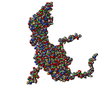+Search query
-Structure paper
| Title | Migration of Type III Secretion System Transcriptional Regulators Links Gene Expression to Secretion. |
|---|---|
| Journal, issue, pages | mBio, Vol. 9, Issue 4, Year 2018 |
| Publish date | Jul 31, 2018 |
 Authors Authors | Spyridoula N Charova / Anastasia D Gazi / Efstratios Mylonas / Charalambos Pozidis / Blanca Sabarit / Dimitrios Anagnostou / Konstantina Psatha / Michalis Aivaliotis / Carmen R Beuzon / Nickolas J Panopoulos / Michael Kokkinidis /    |
| PubMed Abstract | Many plant-pathogenic bacteria of considerable economic importance rely on type III secretion systems (T3SSs) of the Hrc-Hrp 1 family to subvert their plant hosts. T3SS gene expression is regulated ...Many plant-pathogenic bacteria of considerable economic importance rely on type III secretion systems (T3SSs) of the Hrc-Hrp 1 family to subvert their plant hosts. T3SS gene expression is regulated through the HrpG and HrpV proteins, while secretion is controlled by the gatekeeper HrpJ. A link between the two mechanisms was so far unknown. Here, we show that a mechanistic coupling exists between the expression and secretion cascades through the direct binding of the HrpG/HrpV heterodimer, acting as a T3SS chaperone, to HrpJ. The ternary complex is docked to the cytoplasmic side of the inner bacterial membrane and orchestrates intermediate substrate secretion, without affecting early substrate secretion. The anchoring of the ternary complex to the membranes potentially keeps HrpG/HrpV away from DNA. In their multiple roles as transcriptional regulators and gatekeeper chaperones, HrpV/HrpG provide along with HrpJ potentially attractive targets for antibacterial strategies. On the basis of scientific/economic importance, and are considered among the top 10 plant-pathogenic bacteria in molecular plant pathology. Both employ type III secretion systems (T3SSs) of the Hrc-Hrp 1 family to subvert their plant hosts. For Hrc-Hrp 1, no functional link was known between the key processes of T3SS gene expression and secretion. Here, we show that a mechanistic coupling exists between expression and secretion cascades, through formation of a ternary complex involving the T3SS proteins HrpG, HrpV, and HrpJ. Our results highlight the functional and structural properties of a hitherto-unknown complex which orchestrates intermediate T3SS substrate secretion and may lead to better pathogen control through novel targets for antibacterial strategies. |
 External links External links |  mBio / mBio /  PubMed:30065089 / PubMed:30065089 /  PubMed Central PubMed Central |
| Methods | SAS (X-ray synchrotron) |
| Structure data |  SASDEM4: |
| Source |
|
 Movie
Movie Controller
Controller Structure viewers
Structure viewers About Yorodumi Papers
About Yorodumi Papers




 Erwinia amylovora (strain cfbp1430) (bacteria)
Erwinia amylovora (strain cfbp1430) (bacteria)